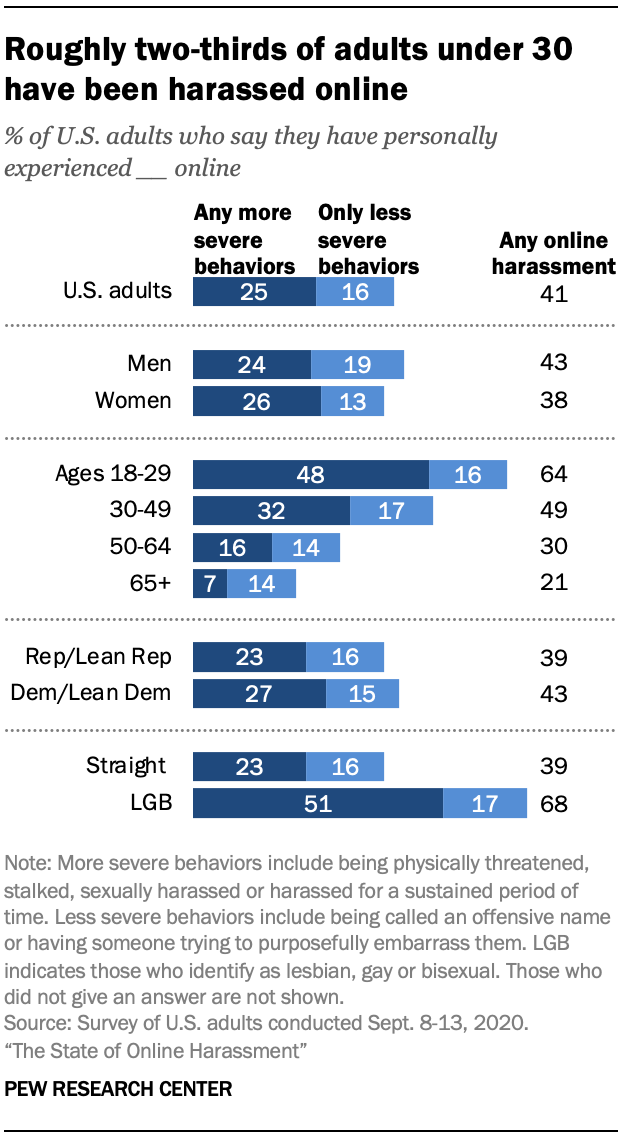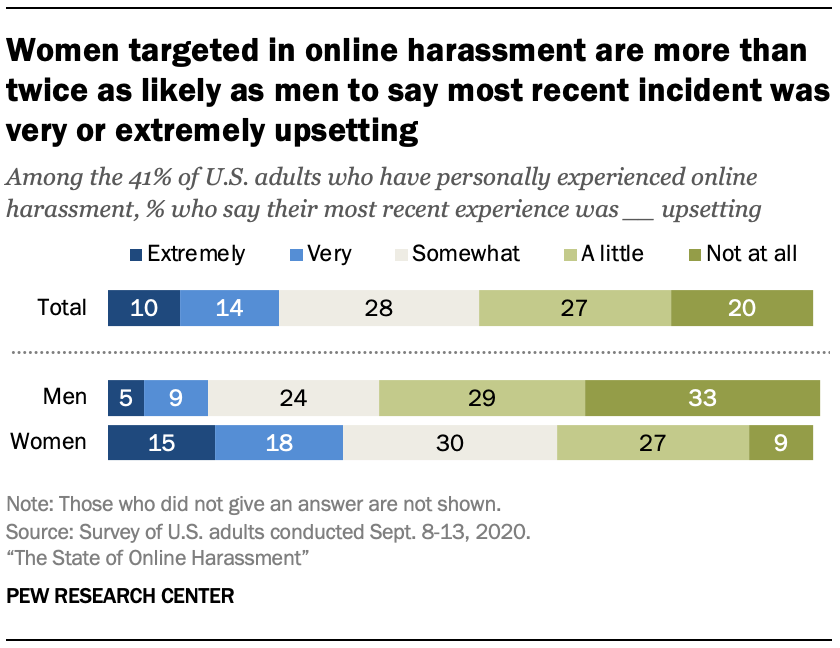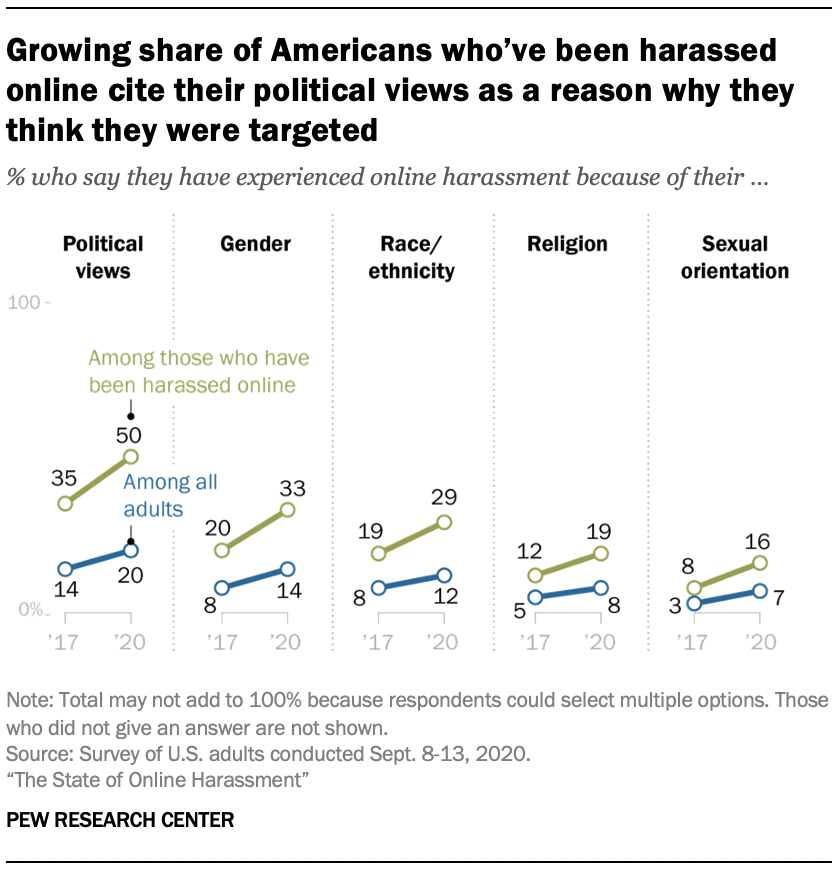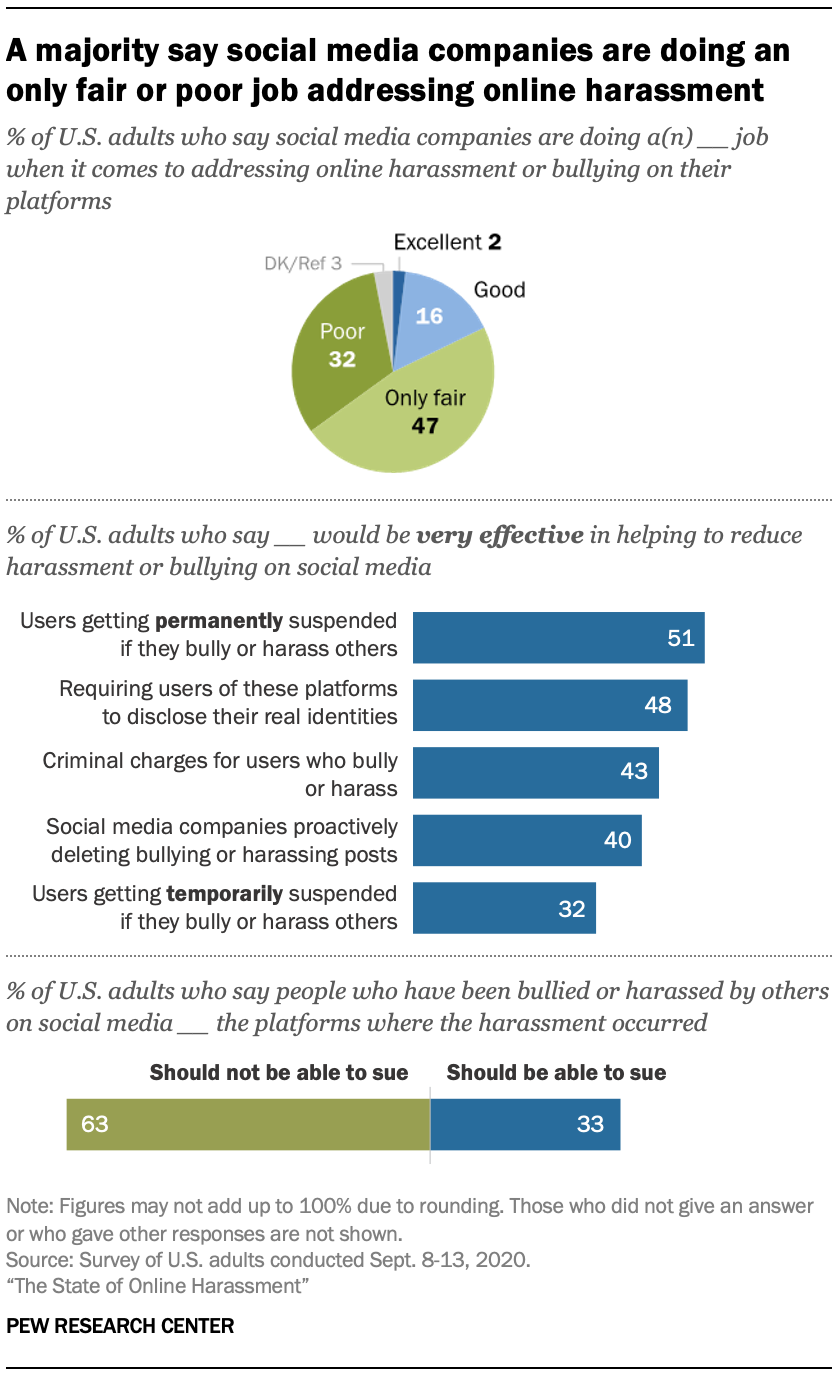Pew Research Center has a history of studying online harassment. This report focuses on American adults’ experiences and attitudes related to online harassment. For this analysis, we surveyed 10,093 U.S. adults from Sept. 8 to 13, 2020. Everyone who took part is a member of the Center’s American Trends Panel (ATP), an online survey panel that is recruited through national, random sampling of residential addresses. This way nearly all U.S. adults have a chance of selection. The survey is weighted to be representative of the U.S. adult population by gender, race, ethnicity, partisan affiliation, education and other categories. Read more about the ATP’s methodology. Here are the questions used for this report, along with responses, and its methodology.
Stories about online harassment have captured headlines for years. Beyond the more severe cases of sustained, aggressive abuse that make the news, name-calling and belittling, derisive comments have come to characterize how many view discourse online – especially in the political realm.

A Pew Research Center survey of U.S. adults in September finds that 41% of Americans have personally experienced some form of online harassment in at least one of the six key ways that were measured. And while the overall prevalence of this type of abuse is the same as it was in 2017, there is evidence that online harassment has intensified since then.
To begin with, growing shares of Americans report experiencing more severe forms of harassment, which encompasses physical threats, stalking, sexual harassment and sustained harassment. Some 15% experienced such problems in 2014 and a slightly larger share (18%) said the same in 2017.1 That group has risen to 25% today. Additionally, those who have been the target of online abuse are more likely today than in 2017 to report that their most recent experience involved more varied types and more severe forms of online abuse.
In a political environment where Americans are stressed and frustrated and antipathy has grown, online venues often serve as platforms for highly contentious or even extremely offensive political debate. And for those who have experienced online abuse, politics is cited as the top reason for why they think they were targeted.
Defining online harassment
This report measures online harassment using six distinct behaviors:
- Offensive name-calling
- Purposeful embarrassment
- Stalking
- Physical threats
- Harassment over a sustained period of time
- Sexual harassment
Respondents who indicate they have personally experienced any of these behaviors online are considered targets of online harassment in this report. Further, this report distinguishes between “more severe” and “less severe” forms of online harassment. Those who have only experienced name-calling or efforts to embarrass them are categorized in the “less severe” group, while those who have experienced any stalking, physical threats, sustained harassment or sexual harassment are categorized in the “more severe” group.
Indeed, 20% of Americans overall – representing half of those who have been harassed online – say they have experienced online harassment because of their political views. This is a notable increase from three years ago, when 14% of all Americans said they had been targeted for this reason. Beyond politics, more also cite their gender or their racial and ethnic background as reasons why they believe they were harassed online.
While these kinds of negative encounters may occur anywhere online, social media is by far the most common venue cited for harassment – a pattern consistent across the Center’s work over the years on this topic. The latest survey finds that 75% of targets of online abuse – equaling 31% of Americans overall – say their most recent experience was on social media.
As online harassment permeates social media, the public is highly critical of the way these companies are tackling the issue. Fully 79% say social media companies are doing an only fair or poor job at addressing online harassment or bullying on their platforms.
But even as social media companies receive low ratings for handling abuse on their sites, a minority of Americans back the idea of holding these platforms legally responsible for harassment that happens on their sites. Just 33% of Americans say that people who have experienced harassment or bullying on social media sites should be able to sue the platforms on which it occurred.
These are some of the key findings from a nationally representative survey of 10,093 U.S. adults conducted online Sept. 8 to 13, 2020, using Pew Research Center’s American Trends Panel. The following are among the major findings.
41% of U.S. adults have personally experienced online harassment, and 25% have experienced more severe harassment

On a broad level, Americans agree that online harassment is a problem plaguing digital spaces. Roughly nine-in-ten Americans say people being harassed or bullied online is a problem, including 55% who consider it a major problem.
Many Americans have also had their own experience with being targeted online. While about four-in-ten Americans (41%) have experienced some form of online harassment, growing shares have faced more severe and multiple forms of harassment. For example, in 2014, 15% of Americans said they had been subjected to more severe forms of online harassment. That share is now 25%. There has also been a double-digit increase in those experiencing multiple types of online abuse – rising from 16% to 28% since 2014. This number is also up since 2017, when 19% of Americans had experienced multiple forms of harassing behaviors online.
Many individual types of behaviors are on the rise as well. The shares of Americans who say they have been called an offensive name, purposefully embarrassed or physically threatened while online have all risen since 2014. However, the share who have experienced any of the less severe behaviors is largely on par with that of 2017 (37% in 2020 vs. 36% in 2017).
A majority of younger adults have encountered harassment online

Online harassment is a particularly common feature of online life for younger adults, and they are especially prone to facing harassing behaviors that are more serious. Roughly two-thirds of adults under 30 (64%) have experienced any form of the online harassment activities measured in this survey – making this the only age group in which a majority have been subjected to these behaviors. Still, about half of 30- to 49-year-olds have been the target of online harassment, while smaller shares of those ages 50 and older (26%) have encountered at least one of these harassing activities.
A similar pattern is present when looking at those who have faced more severe forms of online abuse: 48% of 18- to 29-year-olds have been targeted online with more severe behaviors, compared with 32% of those ages 30 to 49 and just 12% of those 50 and older.
Gender also plays a role in the types of harassment people are likely to encounter online. Overall, men are somewhat more likely than women to say they have experienced any form of harassment online (43% vs. 38%), but similar shares of men and women have faced more severe forms of this kind of abuse. There are also differences across individual types of online harassment in the types of negative incidents they have personally encountered online. Some 35% of men say they have been called an offensive name versus 26% of women, and being physically threatened online is more common occurrence for men rather than women (16% vs. 11%).
Women, on the other hand, are more likely than men to report having been sexually harassed online (16% vs. 5%) or stalked (13% vs. 9%). Young women are particularly likely to have experienced sexual harassment online. Fully 33% of women under 35 say they have been sexually harassed online, while 11% of men under 35 say the same.
Lesbian, gay or bisexual adults are particularly likely to face harassment online. Roughly seven-in-ten have encountered any harassment online and fully 51% have been targeted for more severe forms of online abuse. By comparison, about four-in-ten straight adults have endured any form of harassment online, and only 23% have undergone any of the more severe behaviors.

While men are somewhat more likely than women to experience harassment online, women are more likely to be upset about it and think it is a major problem. Some 61% of women say online harassment is a major problem, while 48% of men agree. In addition, women who have been harassed online are more than twice as likely as men to say they were extremely or very upset by their most recent encounter (34% vs. 14%). Conversely, 61% of men who have been harassed online say they were not at all or a little upset by their most recent incident, while 36% of women said the same. Overall, 24% of those who have experienced online harassment say that their most recent incident was extremely (10%) or very (14%) upsetting.
One-in-five adults report being harassed online for their political views

Those who have been harassed were then asked whether they believed certain personal characteristics – political views, gender, race or ethnicity, religion or sexual orientation – played a role in the attacks. Fully 20% of all adults – or 50% of online harassment targets – say they have been harassed online because of their political views. At the same time, 14% of U.S. adults (33% of people who have been harassed online) say they have been harassed based on their gender, while 12% say this occurred because of their race or ethnicity (29% of online harassment targets). Smaller shares point to their religion or their sexual orientation as a reason for their harassment.
Each of these reasons has risen since the Center last asked these questions in 2017. There have been 6 percentage point increases in the shares of Americans attributing their harassment to their political views as well as gender. Race or ethnicity, sexual orientation and religion each saw a modest rise since 2017.
There are several demographic differences regarding who has been harassed online for their gender or their race or ethnicity. Among adults who have been harassed online, roughly half of women (47%) say they think they have encountered harassment online because of their gender, whereas 18% of men who have been harassed online say the same. Similarly, about half or more Black (54%) or Hispanic online harassment targets (47%) say they were harassed due to their race or ethnicity, compared with 17% of White targets.

While small shares overall say their harassment was due to their sexual orientation, 50% of lesbian, gay or bisexual adults who have been harassed online say they think it occurred because of their sexual orientation.2 By comparison, only 12% of straight online harassment targets say the same. Lesbian, gay or bisexual online harassment targets are also more likely to report having encountered harassment online because of their gender (54%) compared with their straight counterparts (31%).
Men and White adults who have been harassed online are particularly likely to say this harassment was a result of their political views. Harassed men are a full 15 percentage points more likely than their female counterparts to cite political views as the reason they were harassed online (57% vs. 42%). Similarly, White online harassment targets are 18 points more likely than Black or Hispanic targets to point to their political views as the reason they were targeted for abuse online.
And while there are some partisan differences in citing political views as the perceived catalyst for facing harassment, these differences do not hold when accounting for race and ethnicity. For example, White Democrats and Republicans, including independents who lean toward each respective party, who have been harassed are about equally likely to say their political views were the reason they were harassed (55% vs. 57%).
Most online harassment targets say their most recent experience occurred on social media

As was true in previous Center surveys about online harassment, social media continue to be the most commonly cited online venues where harassment takes place. When asked where their most recent experience with online harassment occurred, 75% of targets of this type of abuse say it happened on social media.
By comparison, much smaller shares of this group mention online forums or discussion sites (25%) or texting or messaging apps (24%) as the location where their most recent experience occurred, while about one-in-ten or more cite online gaming, their personal email account or a dating site or app. In total, 41% of targets of online harassment say their most recent experience of harassment spanned more than one venue.
While social media are the most commonly cited online spaces for both men and women to say they have been harassed, women who have been harassed online are more likely than men to say their most recent experience was on social media (a 13 percentage point gap). On the other hand, men are more likely than women to report their most recent experience occurred while they were using an online forum or discussion site or while online gaming (both with a 13-point gap).
Most Americans are critical of how social media companies address online harassment; only a minority say users should be able to hold sites legally responsible
While most Americans feel that harassment and bullying are a problem online, the way to address this issue remains up for debate. The policies used to combat harassment and the transparency in reporting how content is being moderated vary drastically across online platforms. Social media companies have been highly criticized for their current tactics in addressing harassment, with advocates saying these companies should be doing more.

The public is similarly critical of social media companies. When asked to rate how well these companies are addressing online harassment or bullying on their platforms, just 18% say social media companies are doing an excellent or good job. Much larger shares – roughly eight-in-ten – say these companies are doing an only fair or poor job.
Despite most Americans being critical of the job social media companies are doing to address harassment, some are optimistic about a variety of possible solutions asked about in the survey that could be enacted to combat online harassment.
About half of Americans say permanently suspending users if they bully or harass others (51%) or requiring users of these platforms to disclose their real identities (48%) would be very effective in helping to reduce harassment or bullying on social media.
Around four-in-ten say criminal charges for users who bully or harass (43%) or social media companies proactively deleting bullying or harassing posts (40%) would be very effective.
Temporary bans are deemed the least effective solution about which respondents were asked. A third (32%) of Americans say users getting temporarily suspended if they bully or harass others would be a very effective measure against harassment. When it comes to holding social media companies accountable for the harassment on their platforms, few think personal lawsuits should be the solution. A third of adults say people who have been bullied or harassed by others on social media should be able to sue the platforms where the harassment occurred, whereas a much larger share – 63% – believe targets of online abuse should not be able to bring legal action against social media sites.




